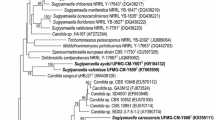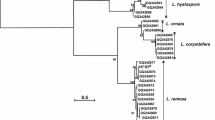Abstract
A thermophilic, strictly anaerobic eubacterium which utilized an unusually limited range of substrates was isolated from a sludge and pulp sample from a paperpulp cooling tank at a paper-board factory in Finland. The organism grew only with beech wood or oat spelt xylan; no growth occurred with soluble sugars, other polysaccharides, peptone, or yeast extract. The organism was rod-shaped, long (up to 20 μm), thin (0.3 μm), gramnegative, and in late-exponential and stationary phase cultures formed “ball of yarn” like structures; endospores were not observed and the organism was not motile. The organism grew fastest (μ=0.08 – 0.09 h-1) at 65 to 75°C and pH 6.5 to 8.4, with a maximum growth temperature between 75 and 80°C and an upper pH limit near 9. During growth on beech xylan the isolate produced only acetate, H2, and CO2 as fermentation products. The guanine + cytosine (G+C) content of the isolates cellular DNA was 34%. The unusual morphology of the isolate is characteristic of the genus Dictyoglomus, and the limited substrate range, higher G+C ratio, and different fermentation products indicated that the isolate was a new species in that genus.
Similar content being viewed by others
References
Angelidaki I, Petersen SP, Ahring BK (1990) Effects of lipids on thermophilic anaerobic digestion and reduction of lipid inhibition upon addition of bentonite. Appl Microbiol Biotechnol 33:469–472
Bergquist PL, Love DR, Croft JE, Streiff MB, Daniel RM, Morgan HW (1989) Genetics and potential biotechnological application of thermophilic and extremely thermophilic archaebacteria and eubacteria. Biotechnol Genet Eng Rev 5:199–244
Biely P (1985) Microbial xylanolytic systems. Trends Biotechnol 3:286–290
Brock TD, Freeze H (1969) Thermus aquaticus gen. n. and sp. n., a non-sporulating extreme thermophile. J Bacteriol 98:289–297
Brock TD (1985) Life at high temperatures. Science 230:132–138
Hudson JA, Morgan HW, Daniel RM (1990) Cellulolytic properties of an extremely thermophilic anaerobe. Appl Microbiol Biotechnol 33:687–691
Huser BA, Wuhrmann K, Zehnder AJB (1982) Methanothrix soehngenii gen. nov. sp. nov., a new acetotrophic non-hydrogenoxidizing methane bacterium. Arch Microbiol 132:1–9
Meshbah M, Premachandran U, Whitman W (1989) Precise measurement of the G+C content of deoxyribonucleic acid by high performance liquid chromatography. Int J Syst Bacteriol 39:159–167
Patel BK, Morgan HW, Wiegel J, Daniel RM (1987) Isolation of an extremely thermophilic chemoorganotrophic anaerobe similar to Dictyoglomus thermophilum from New Zealand hot springs. Arch Microbiol 147:21–24
Puls J, Putanen K (1989) Mechanisms of enzymic hydrolysis of hemicelluloses (xylans) and procedures for determination of the enzyme activities involved. In: Coughlan MP (ed) Enzyme systems for lignocellulose degradation. Elsevier Applied Science, New York, p 151
Sakai T, Kobayashi Y, Kawagoe K, Beppu T (1985) Dictyoglomus thermophilum gen. nov., sp. nov., a chemoorganotrophic, anaerobic, thermophilic bacterium. Int J Syst Bacteriol 35:253–259
Svetlichnii VA, Svetlichnaya TP (1988) Dictyoglomus turgidus sp. nov., a new extreme thermophilic eubacterium isolated from hot springs in the Uzon volcano crater. Mikrobiologiya (Engl. Translation) 57:364–370
Weimer PJ, Zeikus JG (1977) Fermentation of cellulose and cellobiose by Clostridium thermocellum in the absence and presence of Methanobacterium thermoautotrophicum. Appl Environ Microbiol 33:289–297
Wiegel J, Mothershed CP, Puls J (1985) Differences in xylan degradation by various noncellulolytic thermophilic anaerobes and Clostridium thermocellum. Appl Environ Microbiol 49:656–659
Wong KKY, Larry ULT, Saddler JN (1988) Multiplicity of β-1,4-xylanase in microorganisms: functions and applications. Microbiol Rev 52:305–317
Zeikus JG (1979) Thermophilic bacteria: ecology, physiology and technology. Enzyme Microb Technol 1:243–252
Author information
Authors and Affiliations
Rights and permissions
About this article
Cite this article
Mathrani, I.M., Ahring, B.K. Isolation and characterization of a strictly xylan-degrading Dictyoglomus from a man-made, thermophilic anaerobic environment. Arch. Microbiol. 157, 13–17 (1991). https://doi.org/10.1007/BF00245328
Received:
Accepted:
Issue Date:
DOI: https://doi.org/10.1007/BF00245328




